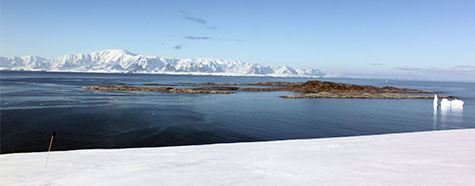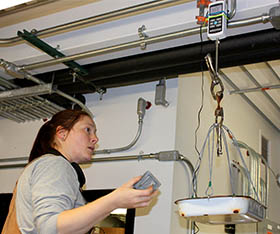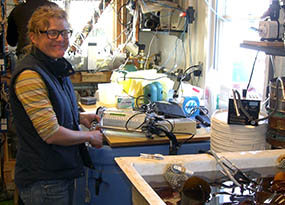
After a string of bad weather days that lasted over a week and kept us from diving anywhere but right from the shore off the station, the last few days have been calm and yesterday and today (Sunday) have been absolutely beautiful. Sunday mornings are our "day off" each week and instead of meeting at 8:00 AM to plan the day we all have free time until 1:00 PM. Maggie hiked up the glacier this morning and took this photo.
At the group meeting, we decided that the afternoon dive would be to collect macroalgae for Julie. She, Kevin, boating coordinator David Moore, who was helping us today, and I had an easy boat ride across glassy calm waters with just a bit of small ice called brash ice to work around. We went to an island called Shortcut because it is along a "shortcut" of a route to some of the southern islands near station.
In my last post I talked about the unusual macroalga (seaweed), Ascoseira, that we traveled to the Lemaire Channel to collect the first week we were at Palmer. Julie and I dove at Shortcut today because it is the spot here where the normal form of Ascoseira is most common. Julie has been using the normal form to make biophysical comparisons with the long stipe form that we got in the Lemaire.

The question that Julie is asking is trying to understand why the Ascoseira in the Lemaire has the long stipes. Our colleague Dick Moe, who as I mentioned in the previous post as the first and only other person to report finding it, told me that the place he collected it had a lot of current. So does the Lemaire, at least sometimes, and we wonder if the long stipes are related to that.
Julie is making several different measurements of the physical characteristics of the stipes that are related to how they might handle the stress of strong current. In the photograph to the left you can see a shaved portion of one of the long stipes on being stretched by having weight added to the pan attached to the bottom. At the top is a meter that measures the force on the alga and Julie measures things like how much it stretches during the process.
I like to kid Julie that she is "torturing" the poor macroalgae as if they were in a medieval torture chamber and being put on "the rack." If you have never seen the movie The Princess Bride, you should (particularly if you need a heartwarming giggle). If you have seen or do see the film, you'll understand why I called where she was doing the experiments the "pit of despair."

We have also wondered about other ways in which the long stipe Ascoseira might be similar to or differ from the normal form. Kate talked about her friend PAM (an instrument to measure photosynthesis) in her last post. Kate made PAM measurements of the Lemaire Ascoseira both underwater there and in the aquarium back here at Palmer. She is doing the same with the normal form. The photo to the right was taken this afternoon of Kate and PAM making measurements in the aquarium of the normal Ascoseira Julie I and I collected.
Although Ascoseira is unusual in so many ways, big brown macroalgae are far from unusual here at Palmer and along the rest of the northern and central Western Antarctic Peninsula region. Big brown algae form undersea forests here in Antarctica. I like to tell people that if they think there are no forests here, they are wrong. They just are not looking in the right place. The right place is under the surface of the sea.
The YouTube site for our UAB in Antarctica web project has a video on The Forests of Antarctica that I put together in 2010. You can see it by clicking on the imbedded video on the left. National Geographic News did a much better job with the video I shot plus some professional video that UAB Media Relations provided. You can that on the web HERE.
Regardless of the source of the images and descriptions, the undersea forests here are amazing. The amount of macroalgae per unit area of the bottom is comparable to the giant kelp forests on the west coast of the US. As I mentioned in my last post, the giant brown algae here are not technically "kelps" but are very much kelp-like in appearance.
My PhD research was done on "true" kelps in the giant kelp forests of south and central California when I was at UC Santa Barbara. I guess one could call them Algae of Unusual Size. After working on much smaller (but no less interesting!) organisms for some years in between, I often marvel on how life has brought me back around to having part of my research being on an Antarctic analog of that earlier love, those giant kelps in California.
I'm in a beautiful place doing something I so enjoy both professionally and personally. And doing so with something akin to a macroalgal "love" I once thought I might not get to be with again. Although I have spent a fair bit of time at sea in between, I didn't even have to turn to piracy. Sometimes it really does work out as you wish.